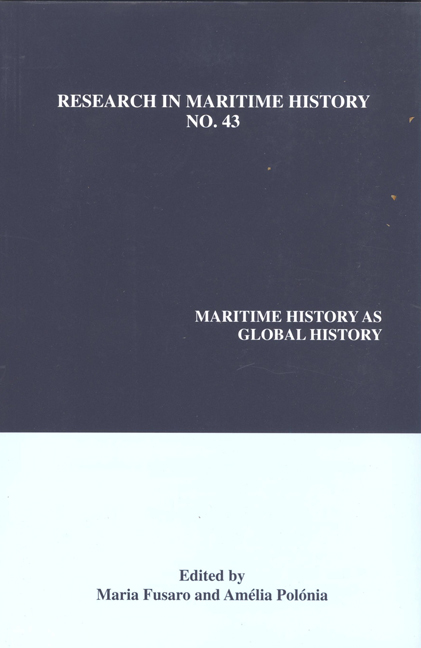Book contents
- Frontmatter
- Contents
- About the Editors
- Contributors' Notes
- “Maritime History: A Gateway to Global History?”
- “Behind the Atlantic Expansion: Flemish Trade Connections of Seville in 1620”
- “National and International Labour Markets for Sailors in European, Atlantic and Asian Waters, 1600-1850”
- “Maritime Expansion and (De)globalization? An Examination of the Land and Sea Trade in Seventeenth-Century Mughal India”
- “From Hold to Foredeck: Slave Professions in the Maritime World of the East India Company, c. 1660-1720”
- “Small Town Merchants, Global Ventures: The Maritime Trade of the New Julfan Armenians in the Seventeenth and Eighteenth Centuries”
- “Lighting up the World? Empires and Islanders in the Pacific Whaling Industry, 1790-1860”
- “Technological Advances in the Maritime Sector: Some Implications for Trade, Modernization and the Process of Globalization in the Nineteenth Century”
- “Lost in Calculation? Norwegian Merchant Shipping in Asia, 1870-1914”
- “Why Are the Major Oil Companies Selling Off their Fleets? The Case of Total”
- “Turning Maritime History into Global History: Some Conclusions from the Impact of Globalization in Early Modern Spain”
- “Maritime History as Global History? The Methodological Challenges and a Future Research Agenda”
“Behind the Atlantic Expansion: Flemish Trade Connections of Seville in 1620”
- Frontmatter
- Contents
- About the Editors
- Contributors' Notes
- “Maritime History: A Gateway to Global History?”
- “Behind the Atlantic Expansion: Flemish Trade Connections of Seville in 1620”
- “National and International Labour Markets for Sailors in European, Atlantic and Asian Waters, 1600-1850”
- “Maritime Expansion and (De)globalization? An Examination of the Land and Sea Trade in Seventeenth-Century Mughal India”
- “From Hold to Foredeck: Slave Professions in the Maritime World of the East India Company, c. 1660-1720”
- “Small Town Merchants, Global Ventures: The Maritime Trade of the New Julfan Armenians in the Seventeenth and Eighteenth Centuries”
- “Lighting up the World? Empires and Islanders in the Pacific Whaling Industry, 1790-1860”
- “Technological Advances in the Maritime Sector: Some Implications for Trade, Modernization and the Process of Globalization in the Nineteenth Century”
- “Lost in Calculation? Norwegian Merchant Shipping in Asia, 1870-1914”
- “Why Are the Major Oil Companies Selling Off their Fleets? The Case of Total”
- “Turning Maritime History into Global History: Some Conclusions from the Impact of Globalization in Early Modern Spain”
- “Maritime History as Global History? The Methodological Challenges and a Future Research Agenda”
Summary
The entry of America into the currents of the European economy caused profound changes. American bullion accelerated and expanded Europe's commerce, and commodities, including food and dyestuffs, changed everyday life. In the other direction, European goods found their way to America as merchants responded to the emerging needs of the new territories. In this essay I will examine the role of Seville as a commercial hub between Europe and America, using Flemish merchant networks of the year 1620 as an example.
In the sixteenth and seventeenth centuries Seville was uniquely positioned to be a conduit between Europe and America. Soon after the first expeditions returned from America, the Spanish crown decided to channel intercontinental trade through a single port, and Seville became the sole staple town for this rich trade. According to contemporary mercantile principles, it was not unusual to grant a single port such a monopoly because it enabled the Spanish crown to control the traffic more easily. Seville's long-distance trade connected the most distant settlements in the Spanish colonies, such as Potosí, with some of the more remote production centres in Europe, such as the Baltic forests and Scandinavian mines. Considering the flow of African merchandise and slaves and the Asian connection through Manila, trade through Seville assumed global dimensions. On these international trade circuits, Seville functioned as a hub because of its monopoly. It was both an Atlantic gateway and the most central port city in what can be called a “proto-global economy.“
The monopoly over the so-called “Indies trade” with America triggered a number of changes in the city. Although Seville had been an important regional trading centre before the sixteenth century, developments following the discoveries of Columbus ushered in its prosperous Siglo de Oro. The city's commercial rise can be seen in the number of merchants resident there. In 1485 a mere twenty-six people called themselves “merchants,” but in 1533 their ranks had swelled to 353. The overall population continued to grow, and between the census of 1533 and that of 1597 Seville's populace doubled from roughly 60,000 to more than 120,000.
The Indies trade was only open to subjects of the Castilian crown and was strictly forbidden for foreigners.” Nevertheless, non-Spaniards had two possibilities to access the riches of the Indies. First, they could make contact with Spanish Indies traders and obtain colonial products through them.
- Type
- Chapter
- Information
- Maritime History as Global History , pp. 21 - 46Publisher: Liverpool University PressPrint publication year: 2010



